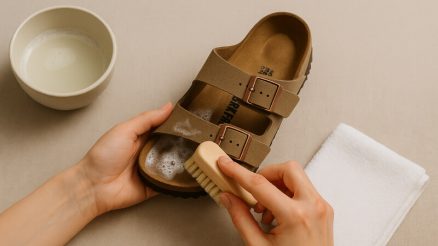We invest in good shoes, hoping they’ll last. But often, before we know it, our favorite pair looks worn out, scuffed, or even falling apart. The culprit isn’t always poor quality or bad luck; it’s often a collection of seemingly innocent daily habits that are silently sabotaging our footwear.
If you want your shoes to last longer, look better, and save you money in the long run, it’s time to identify and ditch these common shoe-ruining practices.
1. Not Rotating Your Footwear
The Habit: Wearing the same pair of shoes day in and day out.
Why it’s Bad: Your feet sweat, and that moisture gets absorbed by the shoe’s lining, sole, and upper materials. If you wear the same pair every day, they don’t get enough time to fully dry out. This constant dampness creates a breeding ground for bacteria (leading to odor), breaks down adhesives, and causes materials like leather to crack and lose their shape. It also concentrates wear and tear on a single pair, accelerating their demise.
The Fix: Invest in a few pairs of shoes suitable for your daily activities and rotate them. Give each pair at least 24-48 hours to air out and dry completely between wears.
2. Improper Storage (Or No Storage at All!)
The Habit: Kicking off your shoes and leaving them in a pile, or stuffing them into a cramped closet.
Why it’s Bad:
- Loss of Shape: Shoes left without support can collapse, causing creases and distorting their original form.
- Dust & Dirt: Shoes left exposed accumulate dust, which can embed itself into materials.
- Environmental Damage: Direct sunlight can fade colors and dry out materials. Damp, dark places can encourage mold and mildew.
- Crushing: Piles of shoes can crush delicate uppers or embellishments.
The Fix:
- Shoe Trees: For leather shoes, use cedar shoe trees. They absorb moisture, maintain the shoe’s shape, and impart a fresh scent.
- Proper Shelving/Racks: Store shoes on racks or in individual boxes to prevent crushing and allow airflow.
- Cool, Dry Place: Keep shoes in a cool, dry, well-ventilated area away from direct sunlight.
3. Neglecting Regular Cleaning
The Habit: Never wiping down your shoes or only cleaning them when they’re visibly filthy.
Why it’s Bad: Dirt, dust, salt, mud, and grime aren’t just unsightly; they’re abrasive. Over time, these particles can scratch and wear down materials, especially leather and suede. Salt, in particular, can cause permanent stains and dry out leather, leading to cracking.
The Fix:
- Daily Wipe-Down: A quick wipe with a damp cloth after each wear can remove surface dirt.
- Scheduled Deep Cleans: Depending on how often you wear them and the conditions, give your shoes a proper cleaning (brushing, conditioning, polishing) regularly.
- Spot Treatment: Address spills and scuffs immediately before they set in.
4. Putting Them On/Taking Them Off Incorrectly
The Habit: Stepping on the heel of your shoes to take them off, or forcing your foot into laced shoes without unlacing them.
Why it’s Bad:
- Damaged Heel Counters: Stepping on the heel crushes the shoe’s internal heel counter, which provides structure and support. Once damaged, the shoe loses its shape and comfort.
- Stretched Uppers: Forcing your foot into a laced shoe without loosening the laces stretches the eyelets, laces, and the shoe’s opening, leading to premature wear and a sloppy fit.
The Fix:
- Use a Shoehorn: Always use a shoehorn to protect the heel counter when putting on shoes.
- Unlace: Take the extra few seconds to unlace your shoes properly before putting them on and taking them off.
5. Wearing the Wrong Shoes for the Activity
The Habit: Wearing dress shoes for a long walk, running in casual sneakers, or wearing delicate flats in heavy rain.
Why it’s Bad: Shoes are designed for specific purposes.
- Lack of Support: Using shoes for activities they weren’t intended for can lead to inadequate support, causing discomfort for your feet and accelerated wear on the shoes (e.g., a dress shoe’s sole isn’t built for impact absorption).
- Material Damage: Delicate materials like suede or satin are easily ruined by wet weather or rough terrain. Running shoes aren’t meant for formal events, and their specialized cushioning will break down faster if used for everyday casual wear.
The Fix: Match your footwear to the occasion and conditions. Have dedicated shoes for exercise, formal events, casual outings, and bad weather.
6. Ignoring Minor Damage
The Habit: Overlooking small scuffs, loose stitching, worn-down heel tips, or thinning soles.
Why it’s Bad: A small problem can quickly escalate into a major, irreparable one. A worn heel tip can expose the internal structure of the heel, leading to instability and further damage. A loose stitch can unravel, causing a seam to split. A thin sole can wear through, exposing your foot to the elements and making the shoe unwearable.
The Fix: Address minor issues promptly. A cobbler can often fix small problems affordably, extending the life of your shoes significantly. Don’t wait until it’s too late!
Conclusion
Our shoes work hard for us, carrying us through countless steps and adventures. By being mindful of these common daily habits, you can dramatically extend the lifespan of your favorite pairs, keep them looking their best, and ultimately save money. A little care goes a long way in preserving your investment in quality footwear.
What are your best shoe care tips? Share them in the comments below!








